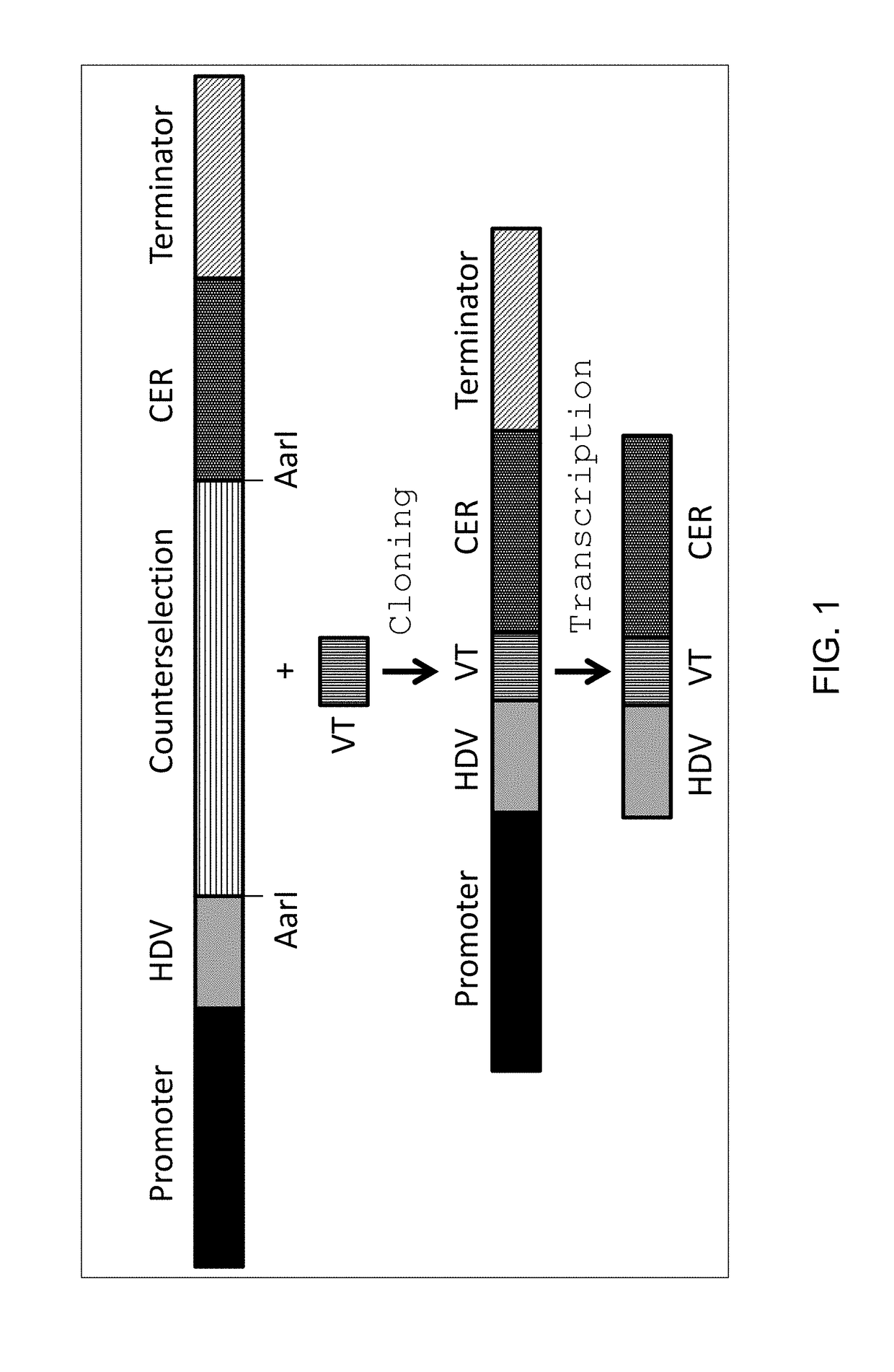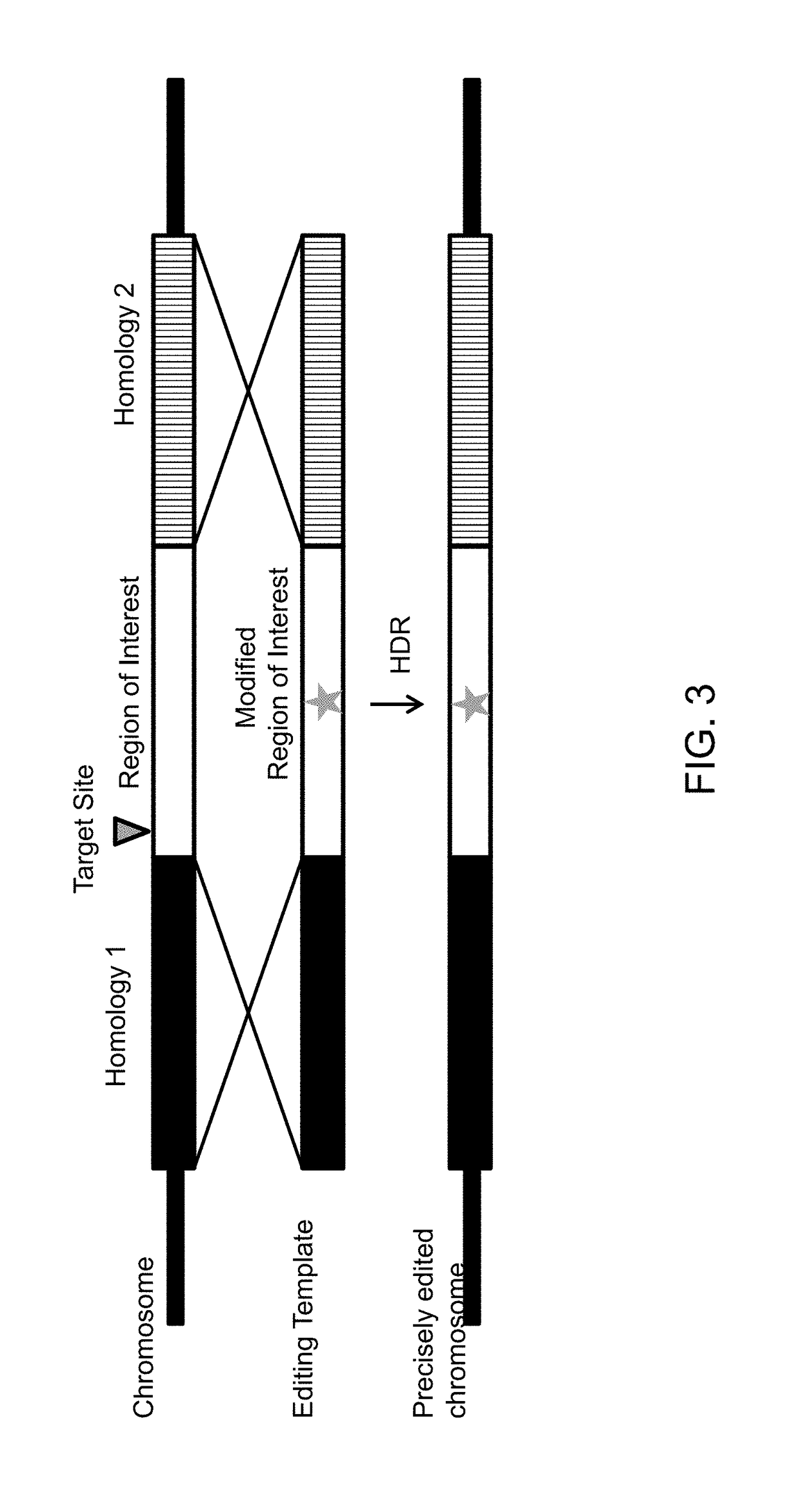Methods and compositions for enhanced nuclease-mediated genome modification and reduced off-target site effects
a genome modification and nuclease technology, applied in the field of molecular biology, can solve the problems of low specificity, low specificity, and high preparation cost, and achieve the effect of reducing or no off-target site effects
- Summary
- Abstract
- Description
- Claims
- Application Information
AI Technical Summary
Benefits of technology
Problems solved by technology
Method used
Image
Examples
example 1
Cas9 HDV-gRNA Expression Plasmid Targeting Can1
[0208]This example discusses the use of sgRNAs that are flanked on the 5′ end by a HDV ribozyme. The HDV ribozyme cleaves 5′ of its own sequence removing any preceding RNA sequence but leaving the HDV sequence fused to the 5′ end of the gRNA.
[0209]In order to test a sgRNA / Cas endonuclease system in Yarrowia, the Cas9 gene from Streptococcus pyrogenes M1 GAS (SF370 (SEQ ID NO: 1) was Yarrowia codon optimized per standard techniques known in the art (SEQ ID NO: 2). In order to localize the Cas9 protein to the nucleus of the cells, Simian virus 40 (SV40) monopartite (PKKKRKV, SEQ ID NO: 3) nuclear localization signal was incorporated at the carboxy terminus of the Cas9 protein. The Yarrowia codon optimized Cas9 gene was fused to a Yarrowia constitutive promoter, FBA1 (SEQ ID NO: 4), by standard molecular biology techniques. An example of a Yarrowia codon optimized Cas9 expression cassette (SEQ ID NO: 5) contains the FBA1 promoter, the Yarr...
example 2
Generation of Linear Polynucleotide Modification (Editing)\ Templates
[0214]A polynucleotide modification template (also referred to as an editing template) was generated by making two PCR products, one, the 629 bp ending 2 bp 5′ of the CAN1 open reading frame (SEQ ID NO: 25) which was amplified from Yarrowia lipolytica ATCC20362 genomic DNA using standard techniques (primers used, GGGAAGCTTGCTACGTTAGGAGAAGACGC (forward, SEQ ID NO: 26) and GGAGAGAGCGTCGGGAGTGGTCGGATGGATGGAGACG (reverse, SEQ ID NO:27)). The reverse primer adds 17 nucleotides complementary to the sequence 37 bp 3′ of the CAN1 open reading frame and the forward primer adds a 5′ HinDIII recognition site. The second PCR product, consisting of 637 bp starting 37 base pairs 3′ of the CAN1 open-reading frame (SEQ ID NO: 28). This PCR product was amplified from Yarrowia lipolytica ATCC20362 genomic DNA using standard techniques (primers used, CGTCTCCATCCATCCGACCACTCCCGACGCTCTCTCC (forward, SEQ ID NO: 29) and CCATACATCCTTCCACC...
example 3
Enhanced Cas9 / sgRNA Precise Gene Modification Using Scr7 Treated Cells and a Linear Editing Template
[0216]In this example Yarrowia lipolytica cells treated with the DNA Ligase IV inhibitor, Scr7, were transformed with targeting plasmids in the presence and absence of editing templates. Homology directed repair (HDR) occurs between an editing template and the target DNA when there are two regions of homology flanking a region of interest (FIG. 3). A DNA double-stranded break at a target site within the region of interest can initiate HDR replacing the region of interest (FIG. 3, white box) with a modified region of interest carried on the editing template. In this example the modified region of interest lacks the entire open-reading frame of the CAN1 gene. Hence, when this linear template is used for homology directed repair, HDR will lead to the deletion of the entire CAN1 open reading frame making the cells Canavanine resistant.
[0217]Cells were phenotypically scored for Canavanine ...
PUM
| Property | Measurement | Unit |
|---|---|---|
| temperature | aaaaa | aaaaa |
| size | aaaaa | aaaaa |
| molecular weight | aaaaa | aaaaa |
Abstract
Description
Claims
Application Information
 Login to View More
Login to View More - R&D
- Intellectual Property
- Life Sciences
- Materials
- Tech Scout
- Unparalleled Data Quality
- Higher Quality Content
- 60% Fewer Hallucinations
Browse by: Latest US Patents, China's latest patents, Technical Efficacy Thesaurus, Application Domain, Technology Topic, Popular Technical Reports.
© 2025 PatSnap. All rights reserved.Legal|Privacy policy|Modern Slavery Act Transparency Statement|Sitemap|About US| Contact US: help@patsnap.com



